I love frying trout and blackening redfish, but every once in awhile I put a few back to learn more and contribute to a higher cause. Find out why I tag fish and how you can, too.
How to Tag Fish
Tagging speckled trout and redfish is an opportunity for anglers to become "citizen scientists" provided by the Louisiana Cooperative Marine Fish Tagging Program, or just TAG Louisiana.
They are part of a collaborative effort between the Louisiana Department of Wildlife and Fisheries, CCA Louisiana and other universities and non-profit organizations.

TAG Louisiana outfits Louisiana anglers with tagging equipment, tags and an online portal to submit and monitor their captures.
They also send you tagging swag, like shirts, lanyards and more for tagging fish or reporting a tagged fish.
How does tagging work?
The concept behind tagging is not exactly rocket science, but it is worth glossing over a few important details.
The idea is for a fish to be captured, its relevant data recorded (usually length overall and capture location), have a tag with an identification number and contact information inserted into its back, then released back into the water.
Sometime in the future that fish will be recaptured by another angler who will see that tag, and report the ID number, fish's capture location and length overall to the contact info located on the tag.
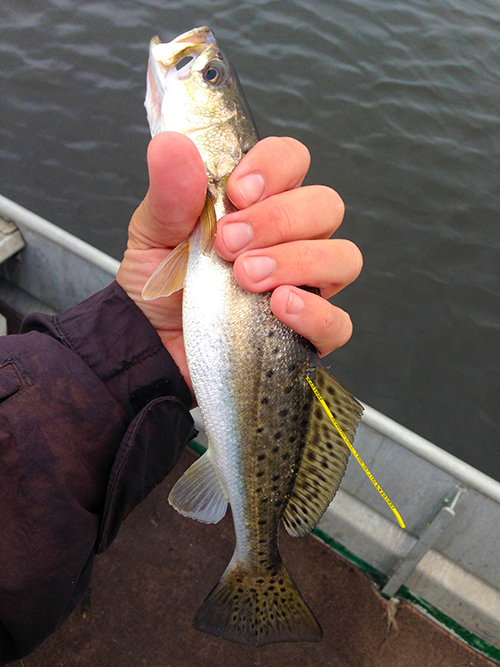
Speckled Trout are tagged the most but recaptured the least. They move a lot and are more difficult to catch than redfish, especially since they move away from easily accessible waters during the summertime.
It's important to note the tags used in the cooperative tagging program are just plastic with ID and contact info on them. They do not emit a signal and are not electronic devices.
Why do we tag fish?
We tag fish to learn more about them. I want you to hold onto your seat as I reveal this stunning information to you:
I do not know everything about speckled trout and redfish, neither does Wildlife & Fisheries.
This is why we tag fish. How fast does a speckled trout or redfish grow? Pretty fast, in some cases.
We also want to learn where fish travel after being tagged. Once you get into tagging you may learn that more questions arise than answers.
TAG Louisiana shares recapture information with the angler who tagged the fish in the first place. This is why the program is said to be "cooperative" because the information is shared between TAG Louisiana and the tagger.
Given the cooperative nature of the tagging program an angler can learn a lot about fish behavior. Where do they go during the summer? Where are they to be found when it gets cold?
These are all things we can learn to essentially help us Fish Smarter as anglers. It also helps Wildlife & Fisheries better manage our incredible resource.
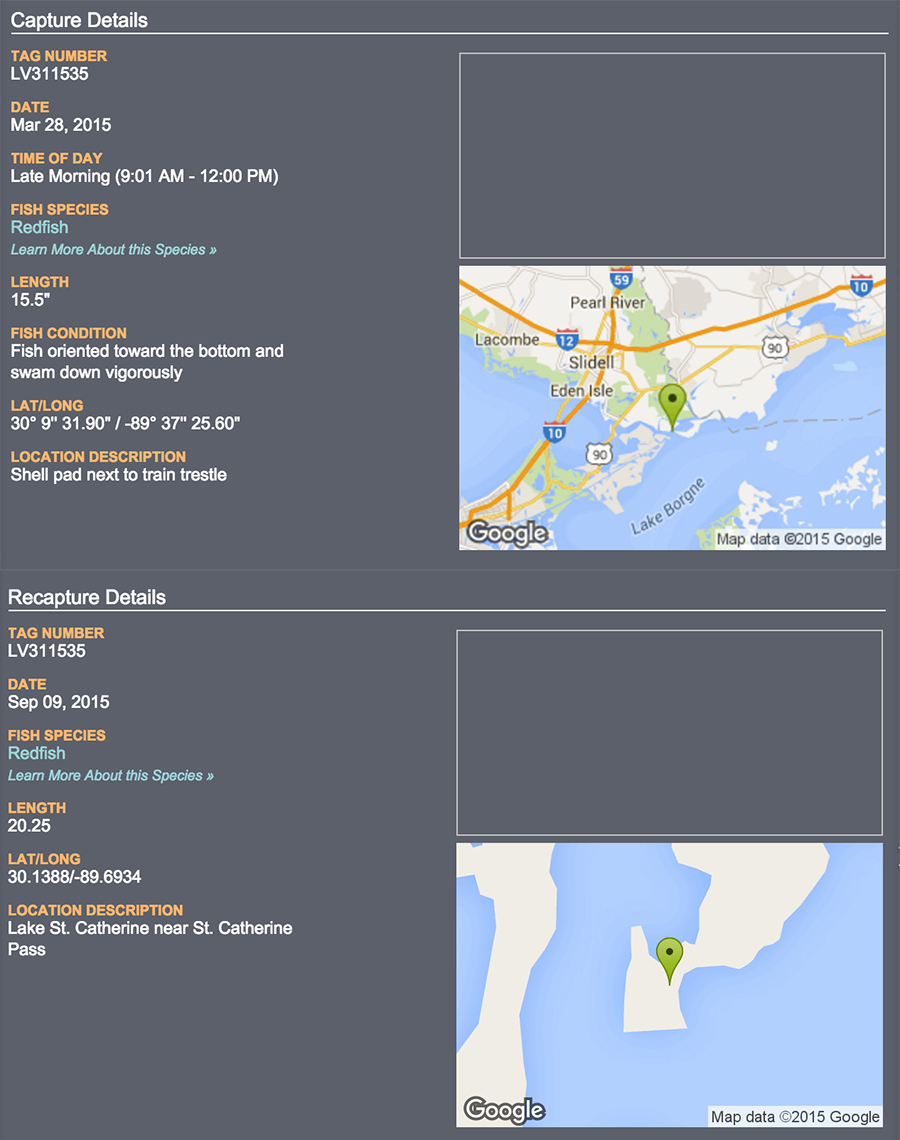
You can see how fast the redfish grew between initial capture and recapture. This is what tagging is all about. You can also see that the redfish stayed oriented towards structure or a shoreline on both occasions.
How you can get started tagging fish.
TAG Louisiana has made it incredibly easy for you to become involved in cooperative fish tagging.
Simply go to their website at www.TAGLouisiana.com and click on "I'd like to Start Tagging."
Once you are there you will fill out some information about yourself, select a shirt size and then receive a tagging kit via snail mail.
After creating an account be sure to come back here and read the rest of what we share to make you an excellent tagger. TAG Louisiana's website is your portal to managing all of your tagging needs. From there you can login, input tag information, view recaptures and order more tags.
These things can be handled by phone and snail mail, but this is the 21st century. Use the portal. It will save everyone a lot of time and energy.
Your Tagging Kit Contents
Your tagging kit includes a tag applicator (the sharp, pointy thing) and tags threaded onto their report cards.
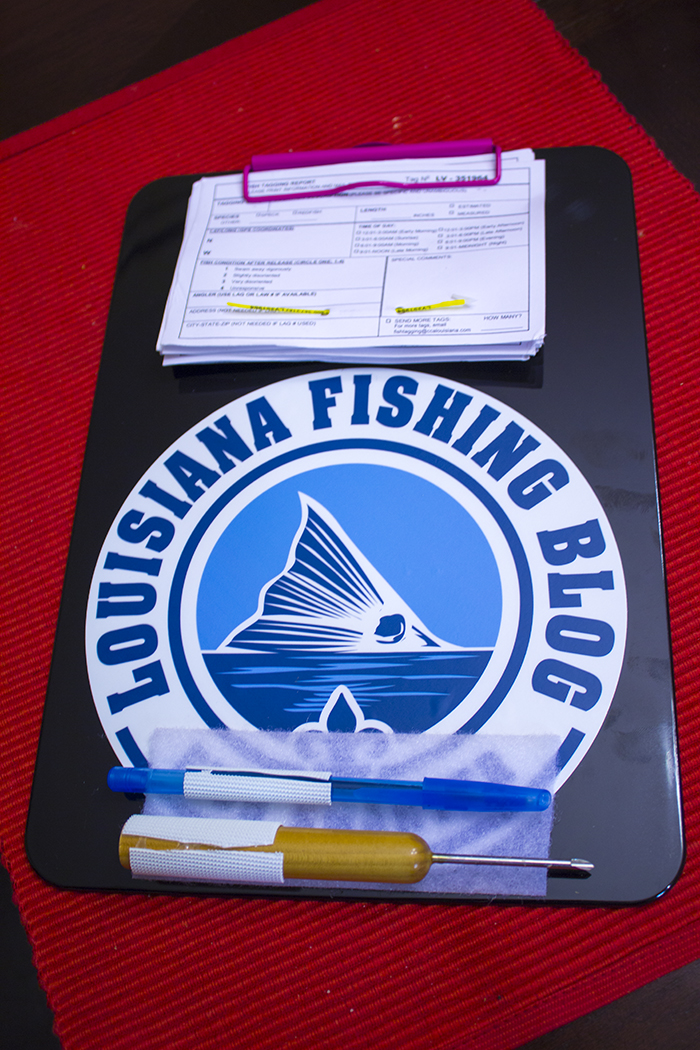
After lots of trial and error I have reorganized my tagging kit onto a clipboard to keep everything in one place. When a report card is filled out I put it in a plastic bag duct taped to the backside. The clip is pink so no one steals my clipboard.
How to Properly Tag a Fish
This is key. Failing to properly insert a dart tag in a timely manner can result in the fish's death. Watch the video below.
Remember to use wet hands or latex gloves to minimally disturb the slime layer coating the fish.
This layer protects the fish against bacterial infection. You want the barb of the tag to catch on the dorsal spine of the fish, decreasing the likelihood of the tag coming out after the fish is released.
Fish Tagging Tips
After tagging about 80 redfish and speckled trout I learned a few things that will ensure the fish survives and cut down on time spent recording information.
Have all Your Tagging Gear Ready
The time to start pulling your tags out of a bag and prep the applicator is not when you just landed the fish. You should have these things done well before you cast that line.
I use a plastic clipboard to organize my tags, report cards, pen and applicator. When I am ready to tag, I keep a tag inside the applicator ready to go and my fish ruler on the deck .
This way the fish spends minimal time out of the water before being tagged and released, ensuring it survives.
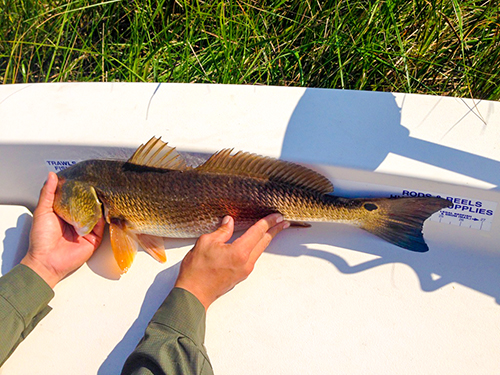
Having something to quickly measure the redfish is key. Stickers like this one do great but are only good for redfish under 27 inches.
When I fill out my report card I use shorthand and let my penmanship go to the wind.
I input all capture information online so I am not worried about looking at my GPS to write down exact lat/long coordinates or how legible my handwriting is.
This will become clear later in the article when I point out how I report my captures.
You can take the time to legibly print all of the capture information, but know you risk missing out on a great trout bite or other redfish swimming down the shoreline.
Hustling Fish to the Boat
You don't want to take forever to get fish into the boat. A fish will exhaust itself to the point of death trying to get loose.
The longer you take will result in it dying after releasing it. This goes back to Fishing Smarter and selecting your gear appropriately to land the fish in a timely manner.
This applies to all fish but matters most with redfish.
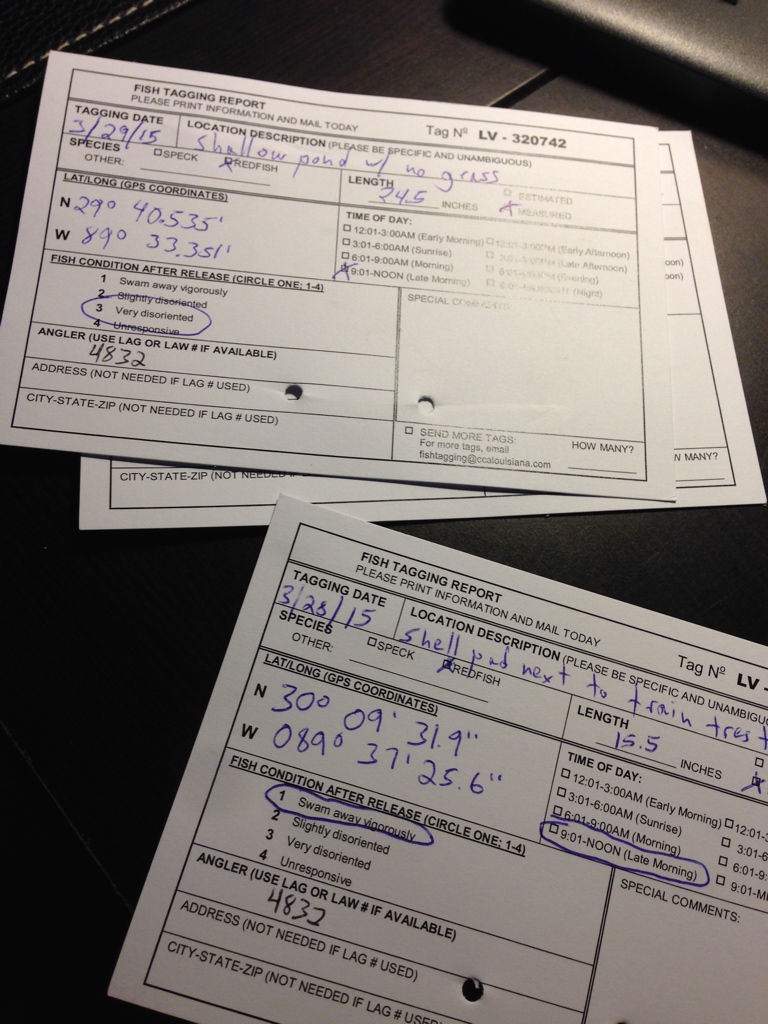
I used to fill cards out completely but now I just use shorthand to quickly jot down information. Later I input that info online on www.TAGLouisiana.com
The days of taking 20 minutes to land a 30" bull red will not last long once you start using correct gear. In fact, I can't tell you the last time it took me that long to land a redfish.
I have hustled 40" redfish into the boat in under a couple minutes because I was using a strong rod and a reel with a good drag. Those redfish get tagged and released.
If I mistakenly catch them on a trout rod and it takes forever to get them to the boat then I will do my best to revive them before releasing them without a tag.
After having a redfish die on me I have learned to be exceptionally careful with how I handle fish.
So for this reason I use a baitcaster with a high drag when targeting redfish, at least 20lbs. The Abu Garcia Revo SX I use features a 20lb drag that will haul the most stubborn redfish straight to the boat.
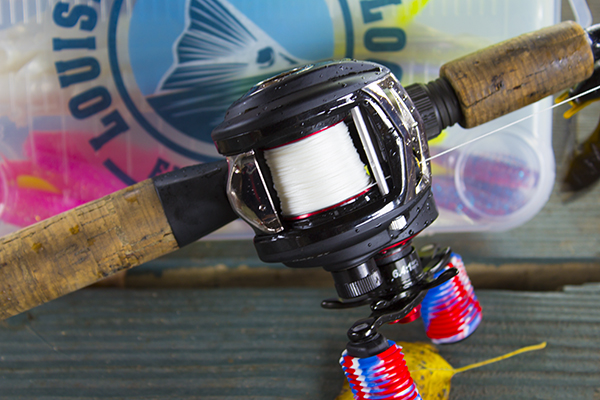
Abu Garcia's Revo SX paired with FINS XS in 30lb test does a great job of winching reds straight into the boat.
Reviving Fish
Since the majority of trout I tag are smaller, being from 9" to 16" long, I don't have problems with them dying.
I'll have them tagged and released back into the water thanks to good organization.
However, redfish may get stressed out a little more, depending on how close they are to the boat when hooked. Some will literally be at the side of the boat when they bite and be immediately launched onto the deck. Others may be 20 yards away and can take longer to land.
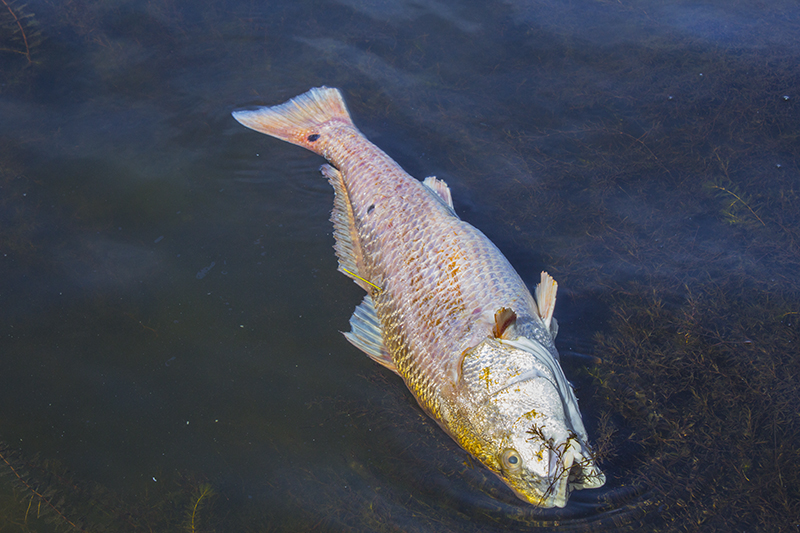
Sadly, this tagged redfish didn't make it. He suffered a prolonged fight through aquatic grass and was so exhausted he died after being released. We found him the day after and removed the tag.
Trout I can toss back into the water right side up and they will strongly swim away.
You don't want to do this with redfish, especially if you are in shallow water. He may end up face down in the mud!
Instead, you want to hold the redfish by his tail with the other hand supporting his belly as you put him in the water and let him breathe, allowing water to flow over his gills and deliver a shot of fresh oxygen.
Completely let go once he starts to pull away on his own.
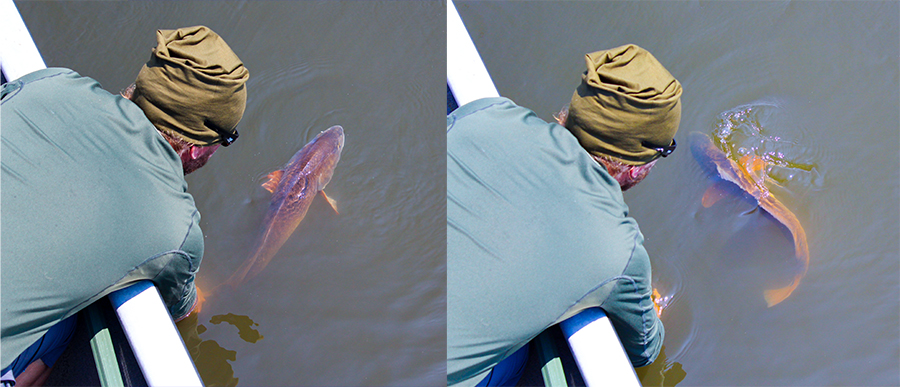
Holding the redfish by the tail, move him back and forth through the water. Release when you feel him trying to swim on his own.
After the Fishing Trip is Over
In the past I filled report cards out to the fullest extent and then mailed them to the TAG Louisiana office in Baton Rouge.
I have discovered that is time consuming, tedious and takes the fun out of tagging.
Today when I am done fishing I will take the filled report cards to my office where I sit down and input information for every tagged fish.
This moves much quicker because tag numbers are automatically generated and repetitive information (like capture location and description) can be saved from one report card to the next. Just watch the video below.
What if I catch a tagged fish?
You can input the recaptured fish's tag info at the TAG Louisiana's website.
You can also call the phone number found on the tag. Calling in a recaptured fish with its tag number, length and capture location will get you some cool TAG Louisiana swag!
Conclusion
I hope you get into tagging fish as much as I have. It is neat to see fish get recaptured and have people kindly report their information. It has made me a better angler and supported a higher cause.
I will be here for years to come and want to see our fishery thrive and this is one way I can see that through.

That’s awesome, but I don’t own or operate the tagging program. Never have, and that wasn’t mentioned in the article. Instead, I was tagging fish (just like your wife) and releasing them in the spirit of conservation. Hope that clears things up.
Thank you for reading!
My wife is one of your taggers. She has requested tags multiple times she loves tagging. Trudi Briede